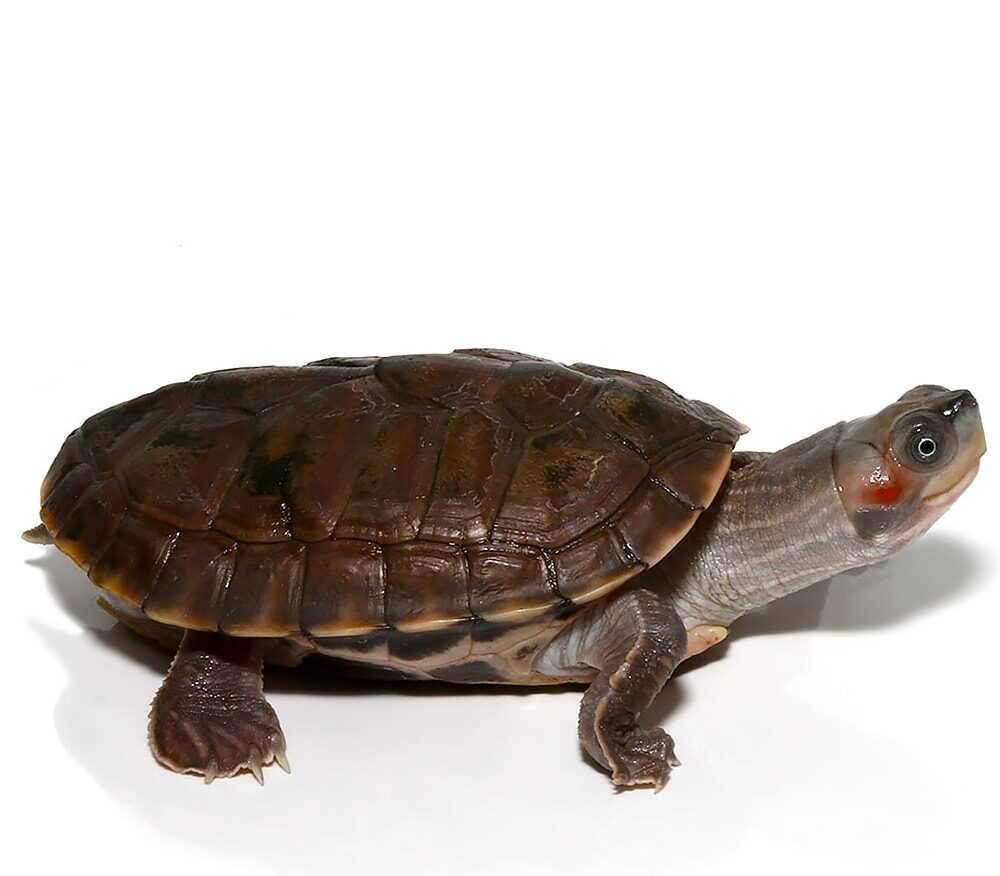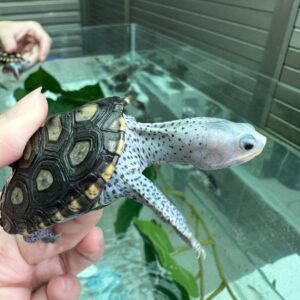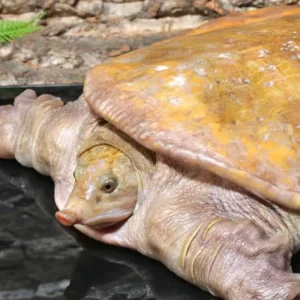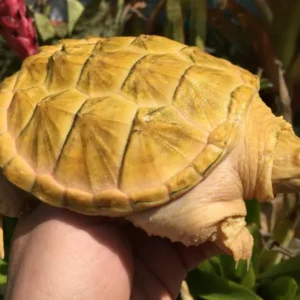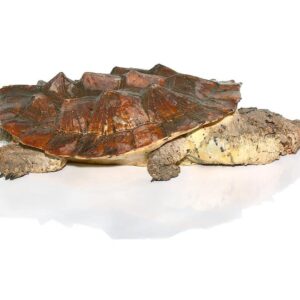Indian Brown Roofed Turtle For Sale
$349.99
WE HAVE BABY INDIAN BROWN ROOFED TURTLE FOR SALE. HERE ARE SOME HIGHLIGHTS:
- Pangshura smithii
- Captive Bred
- Approximately 2 – 3 Inches In Shell Length
- Medium Sizes Species Normally Growing To About 8 – 10 Inches In Shell Length
- Feeding On Turtle Pellets And Various Small Insects Regularly
FUN FACTS!!
- Naturally Occurring Out Of The New Guinea Islands In Indonesia
- Fantastic Chestnut Brown Domed Turtles With A Cherry Blushed Cheeks And Silver Rimmed Eyes
- With Proper Care And Setup These Can Live 20 – 40+ Years In Captivity
- Highly Aquatic Species Living In Slow Moving Streams, And Other Long Lasting Fresh Water Bodies
Description
The Indian Brown Roofed Turtle, scientifically known as Pangshura smithii, is a fascinating species that inhabits the freshwater ecosystems of the Indian subcontinent. Commonly referred to by names such as Smith’s Roofed Turtle or Indian Roofed Turtle, this species plays a vital role in maintaining the ecological balance of its habitat.
Characterized by its distinctive carapace, the Indian Brown Roofed Turtle has a notable roof-like structure on its shell, giving it a unique appearance compared to other turtles. The carapace is typically brown, often adorned with intricate patterns and markings that serve as natural camouflage against predators. The plastron, or the underside of the shell, is generally lighter in color, ranging from pale yellow to cream, often with darker patches.
One of the key features that set the Indian Brown Roofed Turtle apart is its relatively small size. Adult turtles usually measure between 15 to 20 centimeters in length, making them smaller than many other turtle species. Their limbs are well-adapted for swimming, with webbed feet that aid in efficient movement through water. The head is relatively small, and the eyes are prominent, providing excellent vision both underwater and on land.
The Indian Brown Roofed Turtle is an omnivorous species, consuming a varied diet that includes aquatic vegetation, insects, small fish, and other invertebrates. This dietary diversity helps in controlling the population of various aquatic organisms, thus contributing significantly to the health of its ecosystem.
Understanding the basic characteristics and ecological importance of the Indian Brown Roofed Turtle is essential for appreciating its role in biodiversity. This introductory overview sets the stage for a deeper exploration of the species in the subsequent sections of this comprehensive guide.
Habitat and Distribution
The Indian Brown Roofed Turtle (Pangshura smithii) is predominantly found in the freshwater ecosystems of South Asia, specifically in India, Nepal, and Bangladesh. This species exhibits a remarkable adaptability to various aquatic habitats, making it a common sight in many regions within these countries. Its distribution is notably concentrated in the northern and northeastern parts of the Indian subcontinent, where extensive river systems provide ideal living conditions.
These turtles primarily inhabit rivers, ponds, and lakes, where they can often be seen basking on logs or rocks near the water’s edge. The Ganges, Brahmaputra, and their tributaries are among the major river systems that support substantial populations of the Indian Brown Roofed Turtle. The species thrives in environments with slow-moving or still waters, which are rich in aquatic vegetation. Such conditions not only offer abundant food resources but also provide suitable nesting sites and hiding places from predators.
Environmental factors play a critical role in the habitat preferences of the Indian Brown Roofed Turtle. Water quality, temperature, and the presence of vegetation are essential for their survival. Clean, unpolluted waters with moderate temperatures are ideal, as they support the growth of aquatic plants and small invertebrates, which constitute the primary diet of these turtles. Additionally, areas with sandy or muddy substrates are preferred for nesting, as they allow for easy burrowing and egg-laying.
The distribution of the Indian Brown Roofed Turtle is also influenced by seasonal variations. During the monsoon season, increased water levels and the availability of new habitats enable these turtles to expand their range temporarily. Conversely, in the dry season, they may retreat to more permanent water bodies to avoid desiccation and ensure a stable environment.
Physical Characteristics and Identification
The Indian Brown Roofed Turtle, often recognized for its distinct physical attributes, is a species that commands attention due to its unique appearance. One of the most striking features of this turtle is its carapace, or shell, which is moderately domed and possesses a brownish hue with occasional dark markings. The shell’s shape is not only an identifying characteristic but also serves as a protective mechanism against predators. The carapace typically measures between 6 to 9 inches in length, varying slightly between males and females.
Males and females of the species exhibit notable differences in size and morphology. Males tend to be smaller, with narrower, more elongated shells compared to the broader, more oval-shaped carapace of females. Additionally, the plastron, or the underpart of the shell, showcases a pale yellow color with dark brown or black blotches, which can vary in pattern and intensity among individuals.
The coloration of the Indian Brown Roofed Turtle extends to its skin, which is generally a muted brown or grayish tone, blending seamlessly with their natural habitat. Another distinguishing feature includes the presence of a keel or a ridge running along the midline of the carapace, which is more pronounced in juveniles and gradually smoothens as they mature. Juvenile turtles also sport brighter, more vivid markings which tend to fade with age.
Identification can further be refined by observing the turtle’s head and limbs. The head is relatively small, marked by distinctive yellowish lines running from the mouth to the neck, adding to the turtle’s unique visage. The limbs are sturdy, equipped with webbed toes that assist in swimming, and exhibit similar yellowish streaks.
Understanding these physical characteristics is crucial for anyone interested in identifying the Indian Brown Roofed Turtle accurately. Whether in the wild or in captivity, these features provide essential clues to recognizing and appreciating this remarkable species.
Diet and Feeding Habits
The Indian Brown Roofed Turtle, known scientifically as Pangshura smithii, exhibits omnivorous feeding habits, adapting its diet to the availability of resources in its habitat. In the wild, these turtles consume a diverse array of foods, ensuring they meet their nutritional needs for growth and survival.
Primarily, the Indian Brown Roofed Turtle feeds on aquatic vegetation, which forms a significant portion of its diet. They graze on various types of aquatic plants, including algae, water lilies, and other submerged plants, which provide essential vitamins and minerals. This herbivorous inclination is complemented by their consumption of animal matter, making them true omnivores.
These turtles are known to prey on small aquatic animals, such as fish, insects, and other invertebrates. Small fish, including guppies and minnows, are a common part of their diet, offering a rich source of protein. Insects like water beetles, larvae, and crustaceans are also highly favored, providing necessary proteins and fats essential for their health. The Indian Brown Roofed Turtle’s ability to consume a variety of invertebrates, such as snails and worms, further showcases their adaptability and resourcefulness in the wild.
Feeding behavior and patterns of the Indian Brown Roofed Turtle are influenced by environmental factors, such as water temperature and resource availability. These turtles often exhibit diurnal feeding patterns, being most active during the day. They prefer to forage for food in shallow waters where vegetation is abundant and prey is easily accessible. Their feeding habits also vary seasonally, with a higher intake of animal matter during warmer months when prey is plentiful.
Understanding the diet and feeding habits of the Indian Brown Roofed Turtle is crucial for both conservation efforts and captive care. Providing a balanced diet that mimics their natural feeding patterns can help in maintaining their health and well-being in captivity. By replicating their diverse diet, caretakers can ensure these turtles thrive under human care.
Behavior and Lifestyle
The Indian Brown Roofed Turtle, known scientifically as Pangshura smithii, exhibits a fascinating array of behavioral traits and lifestyle patterns that contribute to its survival and adaptability in diverse environments. Primarily diurnal in nature, these turtles are most active during daylight hours. Their activity peaks in the morning and late afternoon, coinciding with optimal basking conditions and foraging opportunities.
Social behavior among Indian Brown Roofed Turtles tends to be relatively solitary compared to other turtle species. While they may occasionally be observed in groups, particularly during basking sessions, these gatherings are more a result of favorable environmental conditions rather than social bonding. Basking is a critical part of their daily routine, as it helps regulate their body temperature and supports metabolic processes. Turtles are often seen sunning themselves on rocks, logs, or riverbanks, retreating to the water when they feel threatened or need to cool down.
Adaptability is a key characteristic of the Indian Brown Roofed Turtle. These turtles are found in a variety of freshwater habitats, including rivers, ponds, and lakes, showcasing their ability to thrive in different environmental conditions. Their diet is omnivorous, consisting of aquatic vegetation, small invertebrates, and occasionally, carrion. This diverse diet further underscores their adaptability and resilience in varying ecological niches.
Unique behaviors have also been documented in this species. For instance, during the dry season, these turtles have been observed burrowing into the mud to avoid desiccation, a behavior known as aestivation. This ability to enter a state of dormancy allows them to withstand periods of unfavorable conditions, ensuring their survival until the environment becomes hospitable again.
In conclusion, the Indian Brown Roofed Turtle’s behavioral patterns, including their diurnal activity, basking habits, and adaptability to diverse environments, highlight their evolutionary success. Understanding these behaviors provides valuable insights into their ecological role and the conservation strategies necessary to protect them.
Reproduction and Lifespan
The reproductive cycle of the Indian Brown Roofed Turtle (Pangshura smithii) is a fascinating aspect of its biology. Mating typically occurs during the warmer months, with male turtles often engaging in courtship behaviors to attract females. These behaviors include a series of head bobbing, nuzzling, and gentle biting. Once a female accepts a male, copulation takes place in the water, which is a common trait among most turtle species.
Nesting sites are crucial for the successful reproduction of the Indian Brown Roofed Turtle. Females seek out sandy or soft soil areas near water bodies to lay their eggs. They prefer secluded spots to minimize the risk of predation. The female turtles dig nests using their hind limbs, creating a chamber where they deposit their eggs. The clutch size can vary but generally ranges from 5 to 15 eggs. After laying the eggs, the female covers the nest with soil to protect the eggs from predators and environmental elements.
The incubation period for the eggs of the Indian Brown Roofed Turtle is influenced by temperature, typically lasting between 60 to 80 days. Warmer temperatures tend to accelerate the incubation process, whereas cooler temperatures may prolong it. This temperature-dependent sex determination is a critical factor in the development of the hatchlings, influencing their gender based on the temperature of the nest.
In terms of lifespan, the Indian Brown Roofed Turtle can live up to 20-25 years in the wild, provided they evade predators and adverse environmental conditions. In captivity, with proper care and a suitable environment, these turtles can live even longer, often reaching 30 years or more. Their longevity in captivity is attributed to controlled diets, reduced predation risk, and medical care.
Conservation Status and Threats
The Indian Brown Roofed Turtle (Pangshura smithii) is currently listed as “Near Threatened” on the International Union for Conservation of Nature (IUCN) Red List. This classification reflects the species’ vulnerability to various environmental and anthropogenic factors that have led to a decline in their population across their natural habitats.
One of the foremost threats to the Indian Brown Roofed Turtle is habitat destruction. Rapid urbanization and industrial development along riverine systems, where these turtles predominantly reside, have resulted in significant loss of their natural habitats. The construction of dams and water diversion projects further exacerbates this issue by altering the flow and quality of water bodies, making them unsuitable for the turtles’ survival and reproduction.
Pollution is another critical threat. Water bodies contaminated with industrial effluents, agricultural runoff containing pesticides and fertilizers, and untreated sewage severely impact the health of these turtles. The accumulation of pollutants in their habitat can lead to severe physiological stress and increased mortality rates.
Climate change poses a long-term threat to the Indian Brown Roofed Turtle. Alterations in temperature and precipitation patterns affect the availability of food resources and suitable nesting sites. Additionally, rising temperatures can skew the sex ratio of hatchlings, given that the sex of turtle embryos is temperature-dependent, potentially leading to population imbalances.
Illegal trade also contributes significantly to the decline of this species. Despite legal protections, the Indian Brown Roofed Turtle is often captured and sold in domestic and international markets for the pet trade and traditional medicine. This exploitation further depletes their already shrinking populations.
Efforts to conserve the Indian Brown Roofed Turtle involve a multi-faceted approach. Legal frameworks such as the Wildlife Protection Act of 1972 in India offer a degree of protection. Conservation organizations are actively involved in habitat restoration projects, pollution control measures, and public awareness campaigns to reduce illegal trade. Furthermore, research and monitoring programs are essential for understanding population dynamics and devising effective conservation strategies.
Tips for Keeping Indian Brown Roofed Turtles as Pets
For those considering the Indian Brown Roofed Turtle as a pet, it is imperative to understand the specific requirements and responsibilities involved in their care. Creating a suitable habitat is the first step. These turtles need a spacious tank with both aquatic and terrestrial areas. The tank should be at least 40 gallons to accommodate their growth and allow for swimming. The water should be kept clean with a filtration system, and the temperature should be maintained between 75-85°F. Additionally, providing a basking area with UVB lighting is crucial for their shell health and overall well-being.
Diet and nutrition are key factors in keeping your Indian Brown Roofed Turtle healthy. These turtles are omnivores, and their diet should include a mix of commercial turtle pellets, leafy greens, and live or frozen prey like insects and small fish. It is essential to provide a balanced diet to ensure they receive all necessary vitamins and minerals. Supplementing their diet with calcium and vitamin D3 is particularly important to prevent shell deformities and other health issues.
Regular health care is another critical aspect of pet ownership. Turtles can be susceptible to a range of health problems, including respiratory infections, shell rot, and parasites. Regular vet check-ups are recommended to monitor their health. Observing your turtle for any signs of illness, such as lethargy, loss of appetite, or abnormal swimming patterns, can help in early detection and treatment of health issues.
Legal considerations also play a vital role in keeping these turtles as pets. It is important to check local regulations and ensure that owning an Indian Brown Roofed Turtle is legal in your area. Some regions may have restrictions or require permits for keeping exotic pets.
Lastly, potential owners must recognize the long-term commitment involved. Indian Brown Roofed Turtles can live for several decades, requiring consistent care throughout their lifespan. This includes routine cleaning of their habitat, provision of a proper diet, and regular health monitoring. The responsibilities and challenges of caring for this species should not be underestimated, and prospective owners should be fully prepared for the commitment.



